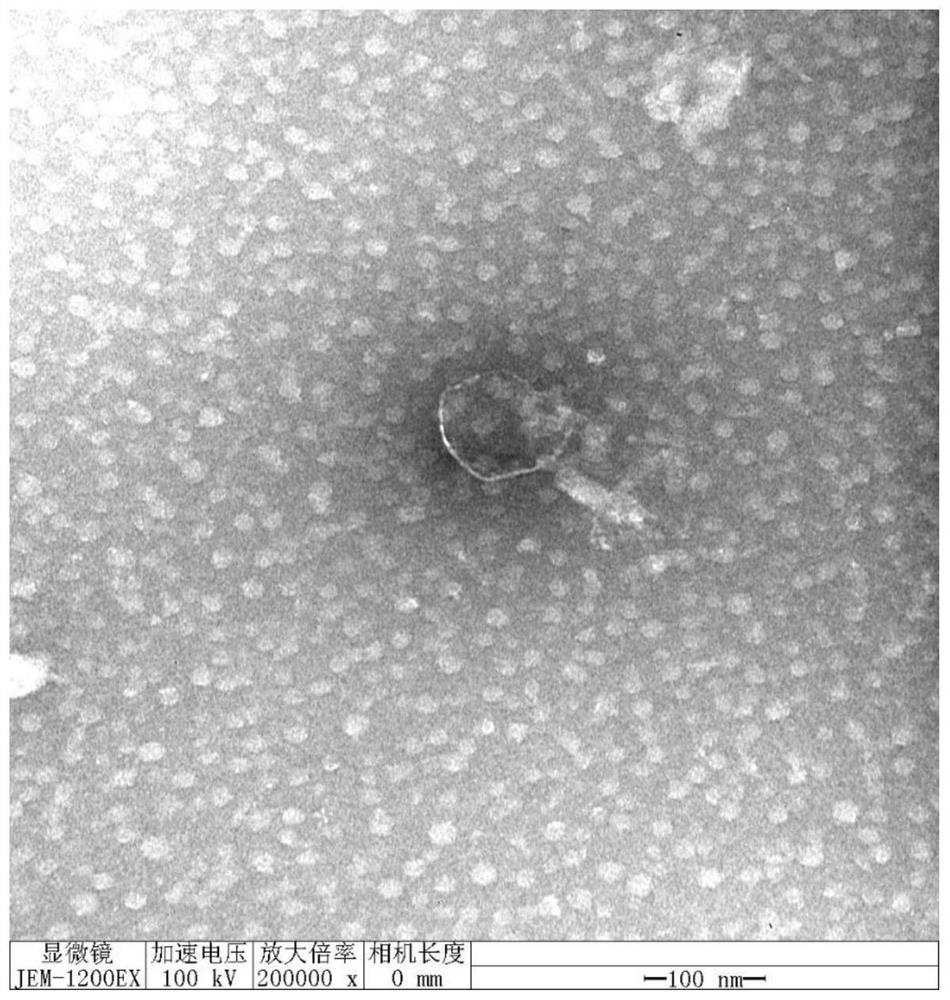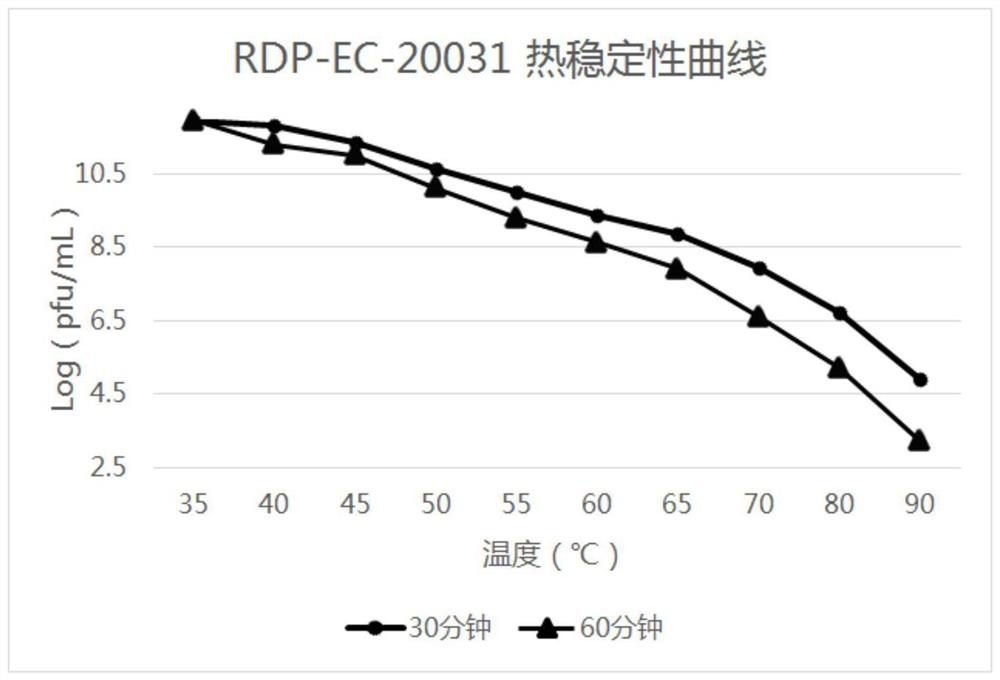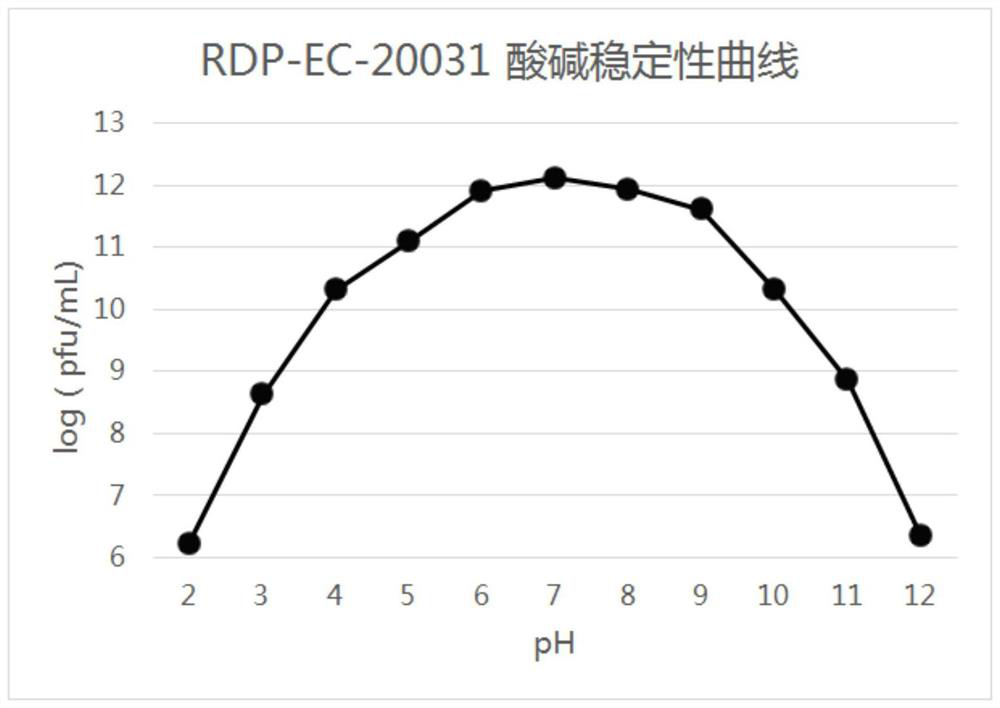A Thermostable Escherichia coli Phage rdp-ec-20031 and Its Application
A RDP-EC-20031, Escherichia coli technology, applied in the direction of virus/bacteriophage, medical raw materials derived from virus/phage, application, etc., can solve problems such as untimely treatment, ineffective medication, and drug resistance of pathogenic bacteria
- Summary
- Abstract
- Description
- Claims
- Application Information
AI Technical Summary
Problems solved by technology
Method used
Image
Examples
Embodiment 1
[0034] Example 1 Isolation and identification of pathogenic Escherichia coli BE-20036
[0035] Sampling from the diseased chicken farm, aseptically take the liver of the diseased chicken, streak it on the selective medium (MacConkey agar medium), cultivate it at 37°C for 18-24 hours, and form a round, flat, edge on the medium For red colonies with neat, smooth and moist surface, pick typical colonies and continue to streak and purify for 3 times, then pick a single colony and inoculate in 5mL LB broth, shake and culture at 37°C and 200rpm for 8h to obtain a uniform turbid bacterial suspension. Then it was identified as Escherichia coli through 16sRNA molecular identification, and its serotype was further determined to be O78 through serum identification. O78 has strong pathogenicity, and can be transmitted to humans through food chains and other methods, and has strong pathogenic infectivity; Name it BE-20036 and store it in a -80°C refrigerator.
Embodiment 2
[0036] Example 2 Isolation and identification of coliphage RDP-EC-20031
[0037] (1) Sewage treatment: Take sewage from the farm, centrifuge at 10,000rpm for 5min, take the supernatant and pass it through a 0.22μm filter, and collect the filtered supernatant for later use.
[0038] (2) Preparation of mixed bacterial suspension: Take 0.2mL of bacterial suspension and 0.3mL of filtrate and add it to 5mL of LB broth, shake and culture overnight at 37°C at 200rpm, then centrifuge at 10,000rpm for 5min, take the supernatant and pass it through a 0.22μm filter. Set aside the filtrate.
[0039] (3) Separation of phages: Separation of phages was carried out using the double-plate method. Take 0.2 mL of the filtrate of the mixed bacterial suspension and 0.2 mL of the Escherichia coli suspension and mix evenly, bathe in water at 37°C for 10 minutes, then spread double plates, and incubate at 37°C for 8 After -12h, observe the result. If there are phages, there will be clear plaques on...
Embodiment 3
[0042] Example 3 Morphological observation of bacteriophage
[0043] Take 20 μL of the liquid containing crude phage particles and drop it on the copper grid, let it settle naturally for 15 min, absorb the excess liquid from the side with filter paper, add a drop of 2% phosphotungstic acid (PTA) on the copper grid to stain the phage for 10 min, and then use The staining solution was sucked from the side of the filter paper, and the morphology of the phage was observed with an electron microscope after the sample was dried. The result is as figure 1 shown.
[0044] Depend on figure 1 It can be seen that the bacteriophage RDP-EC-20031 has a polyhedral stereosymmetric head, wrapped in nucleic acid, with a diameter of about 70nm, a tail with a length of about 90nm, a tail sheath, and a neck connecting the head and the tail. According to the Ninth Report of the International Virus Taxonomy Organization Virus Classification, the phage can be classified as Myoviridae of the order ...
PUM
| Property | Measurement | Unit |
|---|---|---|
| diameter | aaaaa | aaaaa |
Abstract
Description
Claims
Application Information
 Login to View More
Login to View More - R&D
- Intellectual Property
- Life Sciences
- Materials
- Tech Scout
- Unparalleled Data Quality
- Higher Quality Content
- 60% Fewer Hallucinations
Browse by: Latest US Patents, China's latest patents, Technical Efficacy Thesaurus, Application Domain, Technology Topic, Popular Technical Reports.
© 2025 PatSnap. All rights reserved.Legal|Privacy policy|Modern Slavery Act Transparency Statement|Sitemap|About US| Contact US: help@patsnap.com



